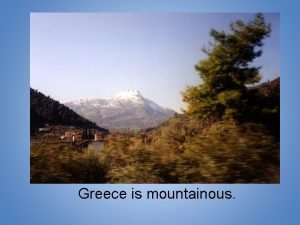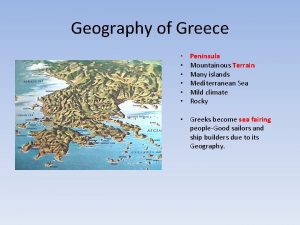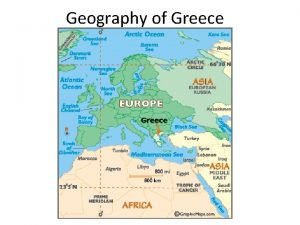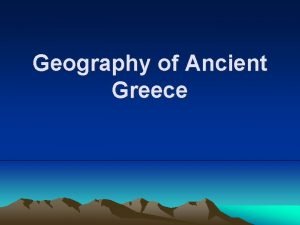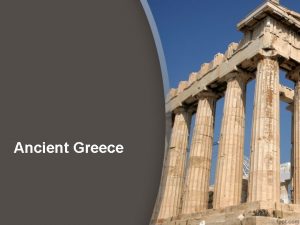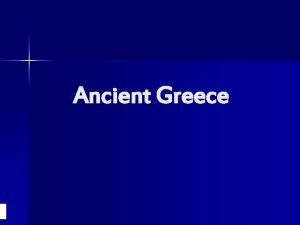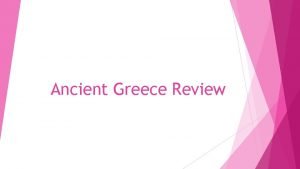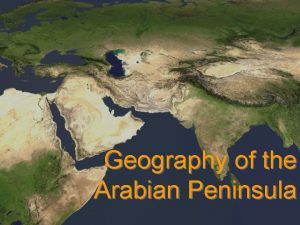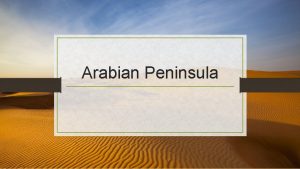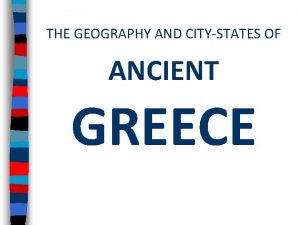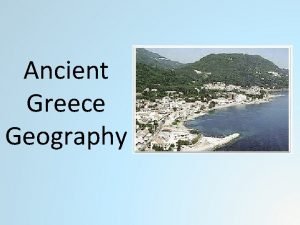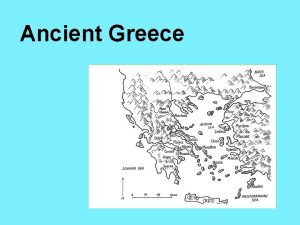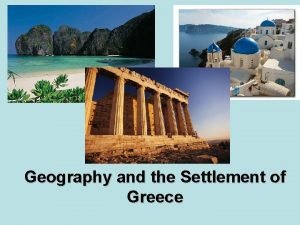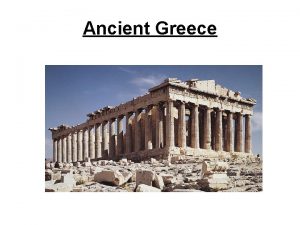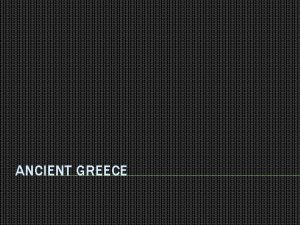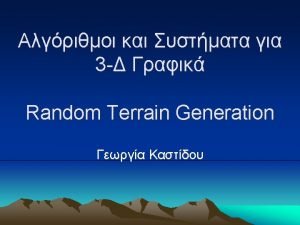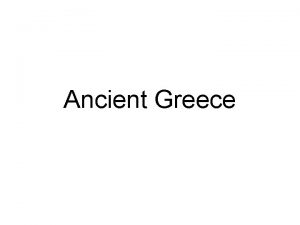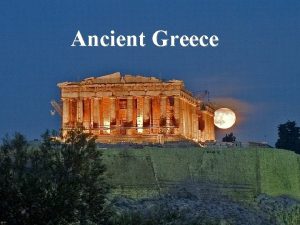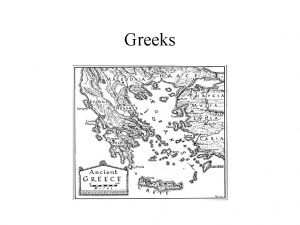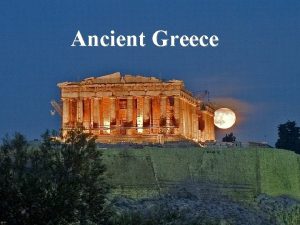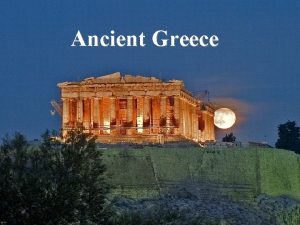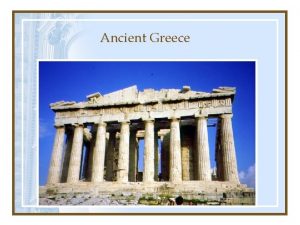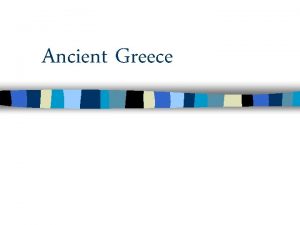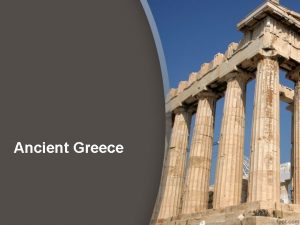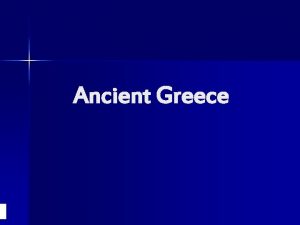Geography of Greece Peninsula Mountainous Terrain Many islands



















- Slides: 19

Geography of Greece • • • Peninsula Mountainous Terrain Many islands Mediterranean Sea Mild climate Rocky • Greeks become sea fairing people-Good sailors and ship builders due to its Geography.

Benefits of living near Mediterranean Sea • Mild climate/Fishing • Able to sail –Sea-fairing people – Increased trade – Interaction with other cultures near/around the Mediterranean Sea.

Development of Greek City-States Mountains and islands ISOLATED Greeks from one another, causing different Greek communities to develop their own ways of life. Each City-State had a unique character.

Which City-State was a Democracy?

Primary economic activity of the Greeks • Location of Greece in the Mediterranean Sea, • Lack of agricultural land availability of harbors led to an economy based on Trade.

Alexander the Great Alexander was the son of Philip II, the king of Macedonia. After Philip’s assassination, Alexander took the throne at only 20 years old. Accomplishments: • Skilled military leader • Took control of the Persian Empire • Extended Greek and Macedonian rule over a vast area in Asia and Egypt. • Hellenistic Culture • Left cultural legacy as Greek language, architecture, literature, art and religion spread throughout parts of Asia and N. Africa

Cultural Diffusion • What is it? ? – the spread of cultural beliefs and social activities from one group to another. The mixing of world cultures through different ethnicities, religions and nationalities has increased with advanced communication, transportation and technology. Example: the Hellenistic Era became the chief agents in the spread of Greek culture in Asia and Egypt. This was the most lasting impact of the conquests of Alexander the Great.

TYPES OF GOVERNMENT • Oligarchy: “the rule of the few”; a form of gov’t in which a select group of people exercises control • Monarchy: gov’t by a sovereign ruler such as a king or queen • Democracy: “the rule of many”; gov’t. by the people, either directly or through their elected representatives • Tyranny: the government or rule of a tyrant or • Anarchy: political absolute ruler disorder; lawlessness

Legacy of the Hellenistic Era Example Arts & Literature • • • Library in Alexandria More emotional/realistic art Epic poems Science, Math, Tech • Earth is round and orbits the sun Discovered pi Specific gravity • • Philosophy • • Epicureanism: free to follow own interests and make happiness a goal Stoicism: happiness can be achieved only when people gain inner peace by living in harmony with will of God Illustration

Geography of Rome/Italy • Peninsula • Apennine Mountains were less rugged than the mountains in Greece. • Fertile plains ideal for farming • Rivers for farming • Mild climate for farming • Mediterranean Sea for trade • Rolling Hills • Coastal Plains • Unlike Greece, Rome becomes an empire.

Roman Republic Government • Patricians-social class of wealthy, landowners, they formed the ruling class in the Roman Republic (Senate) • Plebeians-in the Roman Republic, a social class made up of minor landholders, craftspeople, merchants, and small farmers (assembly) • Senate-a select group of about 300 patricians who served for life. At first, the Senate’s role was to advise government officials. • Consul-a chief executive officer of the Roman Republic; two were elected each year to run the government and to lead the army into battle. • Tribunes: Represented the Plebeians

Plebeians & Patricians • There was often conflict between the two classes in the early Roman Republic. – conflict of orders last for hundreds of years • The council of the Plebs (popular assembly for Plebeians only) was created in 471 B. C. • Tribunes were given power to protect the interest of the Plebeians.

Structure of the Roman Republic

Pax Romana • Means the Roman Peace • Lasted for almost 200 years – Good emperors came to power – Peace, prosperity and glory in the Roman Empire.

Greco-Roman • Roman culture spread and freely mixed with Greek culture. The result has been called Greco-Roman civilization. • Greek culture influenced the Roman culture in many ways. • Art and architecture Science Literature (example: Virgil’s Aeneid was heavily influenced by Greek epic poems)

Legacy of Roman Empire Description Why is it significant? LAW Justice, equality before the law, : Innocent until proven guilty! Shaped later European legal systems LANGUAGE Latin was the language of Rome Several languages evolved from it: Spanish, French, Portuguese, Italian, and Romanian ENGINEERING Build thousands of Developed concrete and miles of roads to the use of arches and connect empire. Built domes bridges & aqueducts CHRISTIANITY Became official religion of Rome in 4 th century after Emperor Constantine’s baptism The adoption of the Christian faith by the Roman Empire was a major turning pt in the spread of Christianity Illustration

Road Network of Rome

Do you understand the difference between B. C and A. D. ?

Vocabulary for CCA Peninsula Isolation City-States Sea-fairing People Terrain Allies Harbors establishing Oligarchy Impact Athenians Legacy Empire controlled B. C. E Territory C. E. Athens Tribunes/ Veto Sparta Pax -Romana Innocent until proven Guilty
 Mountainous peninsula
Mountainous peninsula Greece terrain
Greece terrain Balkan peninsula ancient greece map
Balkan peninsula ancient greece map Ancient greece landforms
Ancient greece landforms Ancient greece map balkan peninsula
Ancient greece map balkan peninsula Why was cyrus considered a fair ruler
Why was cyrus considered a fair ruler Why did the tyrants fall out of favor
Why did the tyrants fall out of favor Ancient greece peninsula
Ancient greece peninsula Rise of greek civilization
Rise of greek civilization Geography of the arabian peninsula
Geography of the arabian peninsula Lesson 2 human geography of the arabian peninsula
Lesson 2 human geography of the arabian peninsula Sparta greece geography
Sparta greece geography Greece geography map
Greece geography map Physical geography greece
Physical geography greece Describe the geography of ancient greece
Describe the geography of ancient greece About 80 percent of the geography of greece is
About 80 percent of the geography of greece is Geography and the settlement of greece
Geography and the settlement of greece Ap human geography frqs
Ap human geography frqs 5 themes of geography ap human geography
5 themes of geography ap human geography Ap human geography political geography test
Ap human geography political geography test
